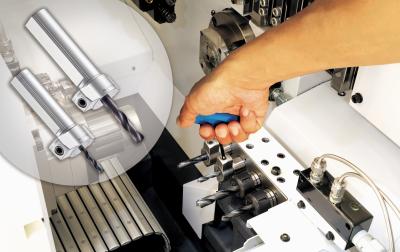
BIG KAISER says its hydraulic chucks for Swiss-type lathes are the first improvement to this technology in more than 30 years. These toolholders use a single wrench, which makes for a quick and easy change of the cutting tools on a gang slide.
Often used for mass production of small items such as automobile parts, watch parts, medical parts, communication and digital equipment parts, Swiss lathes have many fixed and rotating tools in a narrow space, making it difficult to replace a cutting tool inside the machine. To minimize machine downtime and provide operator safety, the hydraulic chucks use a simple hex wrench that requires only two to three turns for both clamping and unclamping.
To help maintain good repeatability and ease of operability, once a hydro-chuck is centered, the runout will not vary, even if a cutting tool is changed repeatedly. Runout of fewer than 3 microns at 4 times diameter can be achieved.
High-precision cutting with hydraulic chucks is achieved on the automatic lathe with a clamping range of ø4-8mm. They are long lasting, maintenance free and the rigidity is greatly improved by the short projection length and dual pressure points.
Hydraulic chucks have a standard pipe thread for coolant through connection and are available for most Citizen and Star machines with 3/4" or 22 mm straight shank.
Contact Details
Related Glossary Terms
- coolant
coolant
Fluid that reduces temperature buildup at the tool/workpiece interface during machining. Normally takes the form of a liquid such as soluble or chemical mixtures (semisynthetic, synthetic) but can be pressurized air or other gas. Because of water’s ability to absorb great quantities of heat, it is widely used as a coolant and vehicle for various cutting compounds, with the water-to-compound ratio varying with the machining task. See cutting fluid; semisynthetic cutting fluid; soluble-oil cutting fluid; synthetic cutting fluid.
- lathe
lathe
Turning machine capable of sawing, milling, grinding, gear-cutting, drilling, reaming, boring, threading, facing, chamfering, grooving, knurling, spinning, parting, necking, taper-cutting, and cam- and eccentric-cutting, as well as step- and straight-turning. Comes in a variety of forms, ranging from manual to semiautomatic to fully automatic, with major types being engine lathes, turning and contouring lathes, turret lathes and numerical-control lathes. The engine lathe consists of a headstock and spindle, tailstock, bed, carriage (complete with apron) and cross slides. Features include gear- (speed) and feed-selector levers, toolpost, compound rest, lead screw and reversing lead screw, threading dial and rapid-traverse lever. Special lathe types include through-the-spindle, camshaft and crankshaft, brake drum and rotor, spinning and gun-barrel machines. Toolroom and bench lathes are used for precision work; the former for tool-and-die work and similar tasks, the latter for small workpieces (instruments, watches), normally without a power feed. Models are typically designated according to their “swing,” or the largest-diameter workpiece that can be rotated; bed length, or the distance between centers; and horsepower generated. See turning machine.
- shank
shank
Main body of a tool; the portion of a drill or similar end-held tool that fits into a collet, chuck or similar mounting device.

